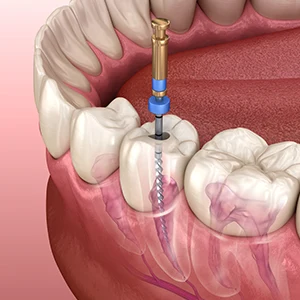If you’re experiencing severe tooth pain, sensitivity, or swelling, chances are your dentist may recommend a root canal. While many people think of it as a one-size-fits-all treatment, there are actually several types of root canal procedures each tailored to different dental needs.
At the Centers for Dental Implants in Aventura, Hallandale Beach, and Pembroke Pines, FL, our expert team uses advanced techniques to determine the best approach for your unique condition. Let’s explore the different types of root canal treatments and how they help restore your oral health.
What Is a Root Canal Procedure?
A root canal is a dental treatment used to remove infected or damaged pulp from inside the tooth. It involves:
- Removing bacteria and decayed tissue
- Cleaning and disinfecting the root canals
- Sealing the tooth to prevent future infection
The goal is to save the natural tooth while eliminating pain and infection. Depending on your condition, one of several types of root canal procedures may be recommended.
1. Conventional Root Canal Therapy (RCT)
This is the most frequently performed root canal procedure, recommended when the tooth’s inner pulp becomes infected or inflamed. The cause is usually deep decay, fractures, or dental trauma. It involves removing the damaged pulp, cleaning the root canals, and sealing the tooth to preserve its structure and prevent reinfection.
How It Works
- Local anesthesia is administered
- An access hole is created in the crown
- Infected pulp is removed and canals are cleaned
- Canals are sealed and a crown is placed
Ideal For
- Single-rooted or multi-rooted teeth with pulp infection
- Patients with moderate to severe tooth pain
- Preserving a natural tooth structure
2. Endodontic Retreatment
Occasionally, a tooth that has already undergone root canal therapy can develop new problems, such as persistent infection or complications from the original treatment. In such cases, endodontic retreatment becomes necessary to remove the previous filling materials, clean and disinfect the canals again, and restore the tooth’s health and function effectively.
How It Works
- Old crown and filling material are removed
- The root canals are cleaned again
- New filling material is placed, and the tooth is resealed
Ideal For
- Teeth with persistent symptoms after a prior root canal
- New decay or cracks affecting the treated tooth
- Patients who want to save their natural tooth rather than extract it
3. Apicoectomy (Surgical Root Canal)
When a standard root canal or retreatment cannot fully resolve the infection, a surgical root canal called an apicoectomy may be required. This minor surgical procedure involves accessing the tooth’s root tip through the gum to remove infected tissue, clean the area, and seal the end of the root for lasting relief.
How It Works
- A small incision is made in the gum
- The tip of the root (apex) is removed
- The area is cleaned and sealed from the root end
Ideal For
- Teeth with hidden or blocked canals
- Root fractures or cysts near the root tip
- Persistent inflammation or infection after standard root canal
4. Pulpotomy
A pulpotomy is a partial root canal procedure commonly used for children or in urgent situations to provide quick pain relief. It involves removing only the infected portion of the tooth’s pulp, allowing the remaining healthy tissue to stay intact and maintain the tooth’s vitality.
How It Works
- Only the infected or inflamed portion of the pulp is removed
- The rest of the pulp and root canals remain intact
- A medicated filling is placed to preserve vitality
Ideal For
- Primary (baby) teeth or immature permanent teeth
- Emergency dental situations
- Cases where complete root canal therapy will follow later
5. Pulpectomy
A pulpectomy is a procedure that involves removing all of the pulp tissue from both the crown and root canals of a tooth. It is often performed as an initial step in managing severe infections or inflammation, especially in children or before completing a full root canal treatment later.
How It Works
- Entire pulp is removed
- Canals are cleaned and shaped
- A temporary filling is placed
Ideal For
- Teeth with severe infection causing intense pain
- Young patients with infected primary teeth
- Teeth awaiting complete root canal treatment
Choosing the Right Procedure for You
At Centers for Dental Implants, we evaluate each patient carefully through X-rays, clinical exams, and digital imaging to determine the best type of root canal procedure.
Our Florida clinics in Aventura, Hallandale Beach, and Pembroke Pines are equipped with the latest tools and technology to provide safe, efficient, and comfortable care.
Led by Dr. Arun K. Garg, an internationally recognized dental educator and oral surgeon, our team has decades of experience in diagnosing and treating complex root canal cases with precision and compassion.
Benefits of Root Canal Procedures
No matter the type, root canal procedures offer several key advantages:
- Pain Relief: Eliminates the source of infection
- Tooth Preservation: Saves your natural tooth
- Oral Health Improvement: Prevents infection from spreading
- Cost-Effective: Avoids future treatments like bridges or implants
- Quick Recovery: Most patients return to daily activities within 1–2 days
FAQs
1. How do I know which type of root canal I need?
Your dentist will evaluate your symptoms, dental history, and X-rays to recommend the most suitable treatment.
2. Are all root canal procedures painful?
No. With modern anesthesia and techniques, most patients report minimal discomfort during the procedure.
3. Can a root canal fail?
While rare, reinfection can occur. In such cases, retreatment or an apicoectomy may be recommended.
4. How long does a root canal last?
With proper care and a crown, a root canal-treated tooth can last a lifetime.
5. What if I need a root canal but I’m pregnant?
Root canals are generally safe during pregnancy, especially in the second trimester. Always inform your dentist.
6. Is a pulpotomy the same as a root canal?
No. A pulpotomy removes only part of the pulp, while a full root canal removes all pulp tissue from the tooth.
7. Do I always need a crown after a root canal?
In most cases, yes especially for back teeth, which need added protection for chewing.
Don’t Ignore Tooth Pain — We’re Here to Help
If you’re experiencing tooth pain, swelling, or discomfort, the right root canal procedure can save your tooth and restore your smile. Let the trusted experts at Centers for Dental Implants guide you toward lasting relief.
Book your appointment today at any of our three Florida locations in Aventura, Hallandale Beach, or Pembroke Pines, and experience exceptional care from a team that treats you like family.


